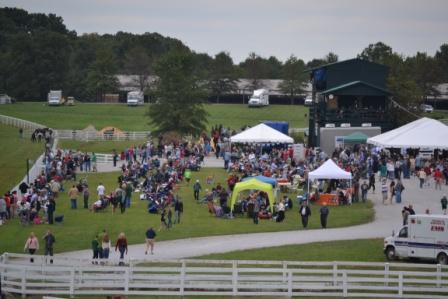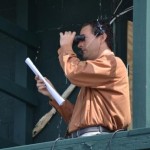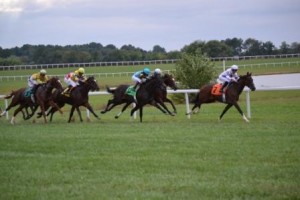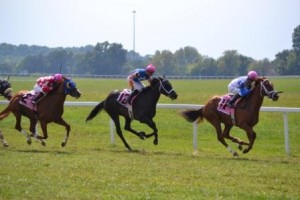Kentucky Downs – A Pastoral and Primal Experience
LIVE Racing in 2018 on September 1,6,8,9,13.
I recently returned to Kentucky Downs for the 2nd consecutive year, and I’m happy to report my experience was exhilarating. At one point I said to my wife, “This is becoming my favorite racetrack to visit.” Without missing a beat, she replied, “You say that about EVERY racetrack that we visit.” Touché.
We do visit a lot of racetracks. Just in the past year, I counted ten altogether. From Saratoga, down to Gulfstream, and all the way up to Emerald Downs in the Pacific Northwest. But Kentucky Downs is different, and in this case I mean “different” in a good way.
As a regular and lifelong horseplayer, I confess that I’m attracted to the simple pleasures of the sport. Seeing and hearing horses in full gallop, listening to the chatter of jockeys, being close to the trainers, horses, and grooms. Kentucky Downs offers this opportunity in spades. At one point a very famous trainer was standing on the rail during the post parade and bantering with the jockeys and outriders passing by. Another time I was discussing the contentious stretch run that resulted in a 3-way photo and a jockey’s objection. Just so happens, my conversation was with the trainer for one of the horses involved in the blanket finish. Where else does that kind of thing happen?
In every race at Kentucky Downs the simple pleasures begin with a preamble by track announcer John Lies (pronounced Lees) that leads to a discussion with paddock commentator Gary West. Listening to these two gentlemen is comforting to the ear.
As a lifelong fan, there weren’t too many things they said that I didn’t already know. But it was just how they said them that kept my attention. It was so much nicer than listening to some public handicapper prattle on about “This horse won on a golden rail last time,” or “That trainer has won 17% of these races on a drop down for a tag.” John and Gary purposely avoid the jargon that turns off many fans.
In my opinion, John Lies is exactly what racetracks need to appeal to new and young fans. He possesses a natural “teaching” quality that makes him both fun to listen to and educational. Prior to a maiden claiming race he explained the nature of this “class” of race and the type of horse that he is looking for when evaluating the contenders.
Regarding how John calls the races, I appreciate the details he provides in his race calls that helps fans decipher exactly how a race was run with regards to pace, trips, jockey movements, etc. He also seems to have an innate ability to pick up on horses making winning moves during a race and bringing attention to them at the earliest possible point.
Gary West is a writer for ESPN most of the year, but during the five days of live racing at Kentucky Downs he provides commentary in the paddock. Gary is like a walking racing encyclopedia, with anecdotes that ranged from the origin of the term “purse” to an explanation of the original name of Kentucky Downs, which was “Dueling Grounds.”
It seems that back in the 19th century, it was lawful in Kentucky to settle differences by way of a pistol duel and the 260-acre grounds that is now Kentucky Downs was a very popular destination. Apparently famous figures such as Andrew Jackson and Sam Houston visited the “dueling grounds” to witness such duels.
In a conversation with Gary, I explained how I was captivated by the whole experience at Kentucky Downs. He replied, “You know, horse racing began in pastoral settings. And I don’t know why more places don’t try to recreate that experience.” I often tell people that Kentucky Downs is what I imagine racing was like 150 years ago. Plunk some chairs down in a field. Mark out a course that goes around that oak tree in the far corner, up the hill on the backside, down and around that pond full of geese, and then back up the hill to end where we started.
From the moment the horses enter the track after leaving the paddock, you feel connected to them. If you are the type of person who benefits from seeing the horses in the flesh before a race, then there is no place like Kentucky Downs to have that experience.
I do not exaggerate when I say you can reach out and touch the horses. I don’t advise it, because moments before a race is not the best time to pet a horse on the nose.
You can hear them breathe. You can see their skin, muscle, hooves, ears, and eyes. Those enormous and beautiful eyes that have a way of finding you and reflecting back your image. You watch as they parade by you, loosening up their limbs, stepping lightly over the green surface, sometimes bouncing as though the grass were made of rubber. If you allow it, the whole experience can be truly surreal.
And then, during the race, when the horses make their run up the gradual incline towards the finish line, you are again only a few feet away from them. You see and hear their effort, as they give everything in their being to run as fast as they can, to get to that finish line ahead of the other horses.
I often wonder; do horses actually know whether or not they won the race? Then you see them return after their gallop out, and you can almost spot the winner even if you hadn’t seen the race. There’s a look, a feeling, a sense of accomplishment. They often stand a bit taller, and implicitly suggest, “Oh yea … I’m the winner.”
So that’s what Kentucky Downs is all about. It’s simple. It’s pastoral. It’s primal. If more racetracks could recreate this experience, I believe there would be no end to the fans that might fall in love with this sport.
Click here to learn more about Kentucky Downs and the truly unique course layout from my 2013 visit.







14 comments on “Kentucky Downs – A Pastoral and Primal Experience”